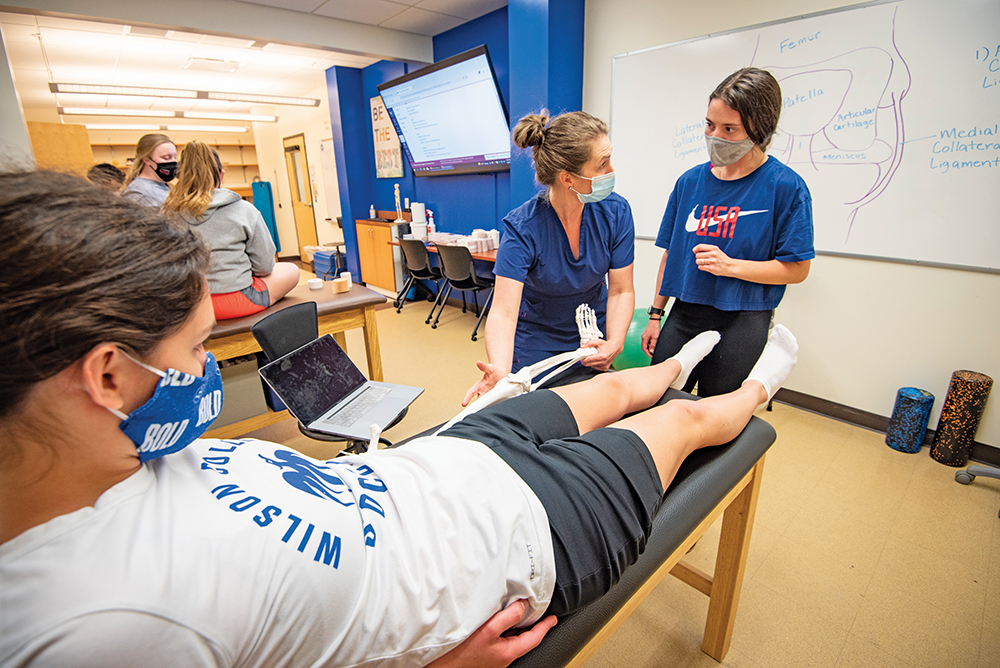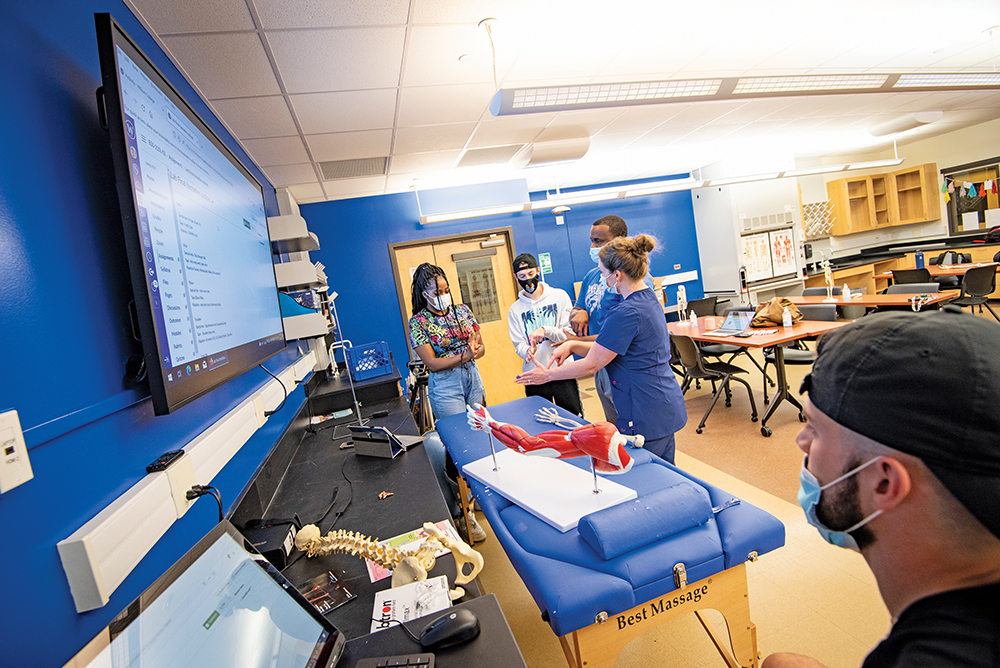By Coleen Dee Berry
Many doors open for Wilson’s exercise science majors.
Interested in becoming a physical therapist, athletic trainer, or personal fitness trainer? Is a career in cardiac rehabilitation or integrative medicine more your style? Or would you like to take the first steps on the path to a chiropractic degree? With a new, dedicated exercise lab and an expanded curriculum, Wilson students pursuing a bachelor’s degree in exercise science have all those options and more.
Exercise science is the gateway to many of the nation’s fastest-growing health and fitness professions. The U.S. Bureau of Labor Statistics expects the overall job growth for the health and fitness industries to increase by 15 percent over the next 10 years.
More than Athletics
Last year, the faculty, led by outgoing Associate Professor of Exercise and Sport Science Tonia Hess-Kling, revamped the College’s exercise science major to allow students to choose from three concentrations: human performance, holistic health, and a pre-professional concentration. “Exercise science has expanded far beyond physical therapy and athletic training,” Hess-Kling said. “The field is now offering so many different career opportunities — everything from treating people recovering from illnesses to cardiac rehab to physical fitness for older people — that we wanted to incorporate those different pathways into the program.”
The growth of the health and fitness industry is driven by the needs of an aging population and a continuing emphasis by the medical profession on preventative care. Hess-Kling noted the COVID-19 pandemic has also contributed to this growth. “Not only has COVID sparked a new interest in overall well-being, but there’s been a ripple effect as well — do we as a society want to take steps to reduce the risk factors and co-morbidities for COVID, such as obesity and diabetes? One way to do that is through increased physical fitness and exercise,” she said.
“Exercise science has been around for quite a while, but recently the focus has shifted,” she said. “Now it’s not just concentrated on physical activity but includes the overall health of a person and encourages viewing the whole person with a mind-body focus. Exercise training has become an important part of the recovery process for many illnesses and surgeries.”
Professional Options
Wilson students are using the major as a springboard to diverse careers.
In the fall of 2021, Payton Dzieumburski ’19 returned to campus to give a presentation on her work in cardiac rehabilitation and demonstrate those techniques to students in Hess-Kling’s classes.
After completing her Wilson studies, Dzieumburski went to the University of Delaware to obtain her master’s in clinical exercise physiology. One year later, she works for a cardiac rehabilitation unit at MedStar Health in Baltimore, Md. “We prescribe exercise as medicine for anyone who has had any sort of heart event, including heart attacks, stents, open-heart surgeries, and more,” she said. “We also have a step-down rehab program that helps prevent future heart events. Anyone with coronary heart disease, high blood pressure, anyone with a higher risk for cardiovascular disease — we can treat them as well.”
The second part of her job involves stress testing for a wide range of patients — from those suffering end-stage heart failure to professional athletes. Dzieumburski usually does a pre-season/pre-participation screening for professional athletes. “I’ve had the pleasure to work with players from the Baltimore Ravens (football) to the Washington Capitals (hockey) to the Orioles (baseball),” she said.
Exercise science major Colby Maun ’22 interned this past fall at Cressey Sports Performance in Palm Beach Gardens, Fla., a high-performance training facility that works with top athletes. “I had the privilege to work with athletes of all skill levels — from middle school to first-ballot Hall of Famers,” Maun said. The internship offered him “the opportunity to work with the coaches, personal trainers, physical therapists, and massage therapists working with professional baseball players such as Justin Verlander, Noah Syndergaard, Miguel Sano, Tres Barrera, Tanner Houck, and Max Scherzer.”
Maun plans to pursue a job in athletic training when he graduates. “My time at Cressey allowed me to develop relationships with professionals who will be lifelong mentors,” he said. “I will be prepared to start in professional baseball development after graduation.”
Senior Kevin Finn is already putting his exercise science major to good use — he has received his personal training certification and is currently working as President Wesley R. Fugate’s trainer. After graduation this May, he intends to pursue a degree to become a physical therapist and work in both the general fitness and sports performance industries.
For the 2021-22 school year, the exercise science program has 34 enrolled students, with 12 seniors graduating this year — the largest graduating class since Hess-Kling began directing the program. Hess-Kling said she had worried that enrollment in the program might drop off because of COVID, but that didn’t materialize, and instead, the program continued to grow. She hopes to hire an additional faculty member for the fall 2022 semester.
A Gleaming New Lab
The program opened its new lab in the Brooks Science Center in the fall of 2019, which was used for one semester before the COVID lockdown began. Hess-Kling said she had to get creative with the online work during the height of the pandemic. “I think it actually worked out rather well. I would have the students practice techniques on their family members — mom, dad, grandma — or their friend or roommate, and take a video to record their process. Then I would assess the video and offer suggestions.” If necessary, the students would repeat the exercise and send another video for evaluation. “So we had them get their family and friends involved in the course,” Hess- Kling said.
Students were able to return to the lab this spring, but COVID forced Hess-Kling to rethink methods of conducting hands-on exercises. “Before, I would have demonstrated a technique on all the students in the class and then have them practice on each other. Now I practice on just one or two students in front of the class to decrease the contact and exposure,” she said. “We’ve been able to continue the hands-on work with lots of masking, shields, hand sanitizer, and washing of hands.”
The lab consists of a lecture room, an athletic training-type evaluation room with three examination tables, and a third room that holds a physiology lab. In the athletic training room, students practice wrapping and taping techniques and conduct different types of orthopedic tests, such as range of motion and strength assessment.
The physiology lab is equipped with two treadmills and two exercise bikes. Students use the iWorx software system to measure heartbeat and glucose, lactic acid, and oxygen levels while other classmates use the exercise equipment.
COVID restrictions also deprived students of the chance to take part in outside observation work, as local hospitals and clinics suspended student participation programs. “But the local fitness, physical therapy, and chiropractic communities in Chambersburg have continued to offer our students internships. We are very grateful to them for all their support over the past two years,” Hess-Kling said.
Before the pandemic, exercise science majors were able to help health workers at the Menno Haven retirement community in Chambersburg with fitness assessments for the residents. “Moving forward, I would like to see us go back to that kind of community-oriented work,” Hess- Kling said. “I want our students to have more community outreach experience. It’s been very difficult with COVID to accomplish that.”
Three Concentrations, Three Pathways
PRE-PROFESSIONAL
This pre-professional concentration prepares students to study and build a strong science and human physiology foundation. This concentration is geared toward those students seeking to apply to graduate school to become a health science or allied health professional in the fields of athletic training, physical therapy, chiropractic, or medicine.
HUMAN PERFORMANCE
This concentration emphasizes learning how to work with people with a variety of health and fitness goals. Students learn foundational knowledge and skills to help them assess human performance and develop strategies for improving physical fitness and performance.
HOLISTIC HEALTH
This concentration emphasizes exploring wellness from a holistic perspective. Students are taught how to live a healthy life, manage stress, understand the benefits of physical activity, and learn about complementary and alternative medicine beyond traditional Western Medicine techniques.



